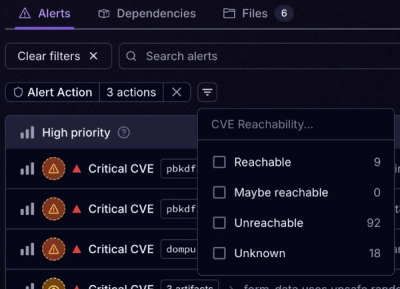
Product
Announcing Socket Fix 2.0
Socket Fix 2.0 brings targeted CVE remediation, smarter upgrade planning, and broader ecosystem support to help developers get to zero alerts.
@philnash/astro-pagination
Advanced tools
A flexible, accessible pagination component for displaying links to next, previous, first, last and a window of pages in your Astro site.
A flexible, accessible <Pagination> component for displaying links to next, previous, first, last and a window of pages in your Astro site.
Install the component using npm:
npm install @philnash/astro-pagination
If you are displaying a page that uses the Page type, you can pass that Page to this component and it will render a set of links to other pages. You also need to pass a URL pattern for how the paths to each page are created. A URL pattern should contain the URL itself and empty brace {} where the page number goes.
For example:
---
import { Pagination } from "@philnash/astro-pagination";
type Props = {
page: Page<CollectionEntry<"blog">>;
};
const { page } = Astro.props;
---
<Pagination page={page} urlPattern={"/blog/page/{}"} />
The above code will render a result like:
<nav role="navigation" aria-label="Pagination">
<ul>
<li>
<a
href="/blog/page/4"
class="previous-page"
aria-label="Go to previous page"
>« Prev</a
>
</li>
<li>
<a class="number" href="/blog/page" aria-label="Go to page 1"> 1 </a>
</li>
<li>
<span class="start-ellipsis">…</span>
</li>
<li>
<a class="number" href="/blog/page/3" aria-label="Go to page 3"> 3 </a>
</li>
<li>
<a class="number" href="/blog/page/4" aria-label="Go to page 4"> 4 </a>
</li>
<li>
<em aria-current="page" aria-label="Current page, page 5"> 5 </em>
</li>
<li>
<a class="number" href="/blog/page/6" aria-label="Go to page 6"> 6 </a>
</li>
<li>
<a class="number" href="/blog/page/7" aria-label="Go to page 7"> 7 </a>
</li>
<li>
<span class="end-ellipsis">…</span>
</li>
<li>
<a class="number" href="/blog/page/10" aria-label="Go to page 10"> 10 </a>
</li>
<li>
<a href="/blog/page/6" class="next-page" aria-label="Go to next page"
>Next »</a
>
</li>
</ul>
</nav>
The pagination markup is surrounded by a <nav> element which has a role of "navigation" and an aria-label describing it as "pagination" for assistive technologies.
It creates a list of links to make it easy to navigate, including links for the previous and next page, links for the first and last pages, ellipses to show a gap, and a window of links around the current page. For each of the links there is also an aria-label to describe the link. The current page is not linked, and has the attribute aria-current="page" as well as being labelled as the current page.
page (Page<T>)The page as provided by the props to the page.
urlPattern (string)A URL pattern should contain the path and an empty brace {} where the page number goes. For example, "/blog/page/{}"
You can control a number of options for the pagination component by passing different properties. Those properties are listed below:
windowSize (number, default: 5)The number of links that appear around the current page. It is best to choose an odd number so that the number of links either side are even.
showPrevNext (boolean, default: true)Whether to show the previous and next links
previousLabel (string, default: "« Prev")The label of the previous link
nextLabel (string, default: "Next »")The label of the next link
showFirstLast (boolean, default: true)Whether to show the first and last links
firstPageUrl (string)By default this component will set the first link as something like "/blog/page" and subsequent pages, as "/blog/page/${n}". I personally have the first page of my blog at "/blog" and then subsequent pages at "/blog/page/${n}", and to accomplish this I set the firstPageUrl to "/blog"
An example using some of these options might look like this:
---
type Props = {
page: Page<CollectionEntry<"blog">>;
};
const { page } = Astro.props;
---
<Pagination
page={page}
urlPattern={"/items/page/{}"}
firstPageUrl="/items"
windowSize={3}
showPrevNext={false}
/>
This would create something like:
<nav role="navigation" aria-label="Pagination">
<ul>
<li>
<a class="number" href="/items" aria-label="Go to page 1"> 1 </a>
</li>
<li>
<span class="start-ellipsis">…</span>
</li>
<li>
<a class="number" href="/blog/page/4" aria-label="Go to page 4"> 4 </a>
</li>
<li>
<em aria-current="page" aria-label="Current page, page 5"> 5 </em>
</li>
<li>
<a class="number" href="/blog/page/6" aria-label="Go to page 6"> 6 </a>
</li>
<li>
<span class="end-ellipsis">…</span>
</li>
<li>
<a class="number" href="/blog/page/10" aria-label="Go to page 10"> 10 </a>
</li>
</ul>
</nav>
MIT (c) Phil Nash 2023
FAQs
A flexible, accessible pagination component for displaying links to next, previous, first, last and a window of pages in your Astro site.
The npm package @philnash/astro-pagination receives a total of 270 weekly downloads. As such, @philnash/astro-pagination popularity was classified as not popular.
We found that @philnash/astro-pagination demonstrated a healthy version release cadence and project activity because the last version was released less than a year ago. It has 1 open source maintainer collaborating on the project.
Did you know?

Socket for GitHub automatically highlights issues in each pull request and monitors the health of all your open source dependencies. Discover the contents of your packages and block harmful activity before you install or update your dependencies.

Product
Socket Fix 2.0 brings targeted CVE remediation, smarter upgrade planning, and broader ecosystem support to help developers get to zero alerts.

Security News
Socket CEO Feross Aboukhadijeh joins Risky Business Weekly to unpack recent npm phishing attacks, their limited impact, and the risks if attackers get smarter.

Product
Socket’s new Tier 1 Reachability filters out up to 80% of irrelevant CVEs, so security teams can focus on the vulnerabilities that matter.